
‘So


‘So
By Zachary Smith | z.smith@mycityjournals.com
“There are very few other jobs in the world that can impact so many people’s lives for the better. It’s been a wonderful experience to get to work with kids for so many years.”
In2013, Neil Armstrong Academy opened in the West Valley City Highbury area. Unlike other K-6 schools, or any other school in West Valley at the time, for that matter, it was a STEM school. Neil Armstrong made city-wide headlines for being the first school in the valley to implement a STEM-focused curriculum designed to teach skills required for careers in science, technology, engineering and mathematics at an early age. The overwhelming success of Neil Armstrong’s STEM curriculum prompted several other schools in West Valley to integrate STEM learning.
The STEM initiative in West Valley City began with Dr. Tyler Howe, the first principal at Neil Armstrong Academy. Because of his incredible success at Armstrong, Howe received the Granite School District Principal of the Year award in 2015. He went on to become principal at West Lake STEM Junior High shortly after it adopted the STEM curriculum, and he later worked as principal at Granger High School. As of Feb. 4, Howe was appointed as Granite School District’s assistant superintendent.
Howe, a Cottonwood Heights resident, didn’t always intend to be an educator. In fact, he originally wanted to pursue a career path in business. In college, he switched his major to Elementary Education when he realized he had a passion for working with students in a classroom environment.
“It’s a privileged position,” Howe said in an interview with The City Journals. “There are very few other jobs in the world that can impact so many people’s lives for the better. It’s been a wonderful experience to get to work with kids for so many years.”
Howe is a firm believer in the benefits and impact of handson learning, which drives his involvement with the push for STEM education. He recounted several STEM projects that he participated in alongside students at Neil Armstrong Academy, such as teaching ballistics and trajectory by building catapults, and the Bungee Barbie competition, in which students attempted to figure out how to drop a Barbie doll from the roof of the school without making a collision with the ground.
“STEM is really the way a lot of us want to discover things,” Howe said. “It’s not always ‘does the teacher have the right answer?’ All of these fields are a lot more ‘I wonder if this could work, let’s try it. Now it did, or maybe it didn’t, so let’s try it another way.’ There’s a fun process in that.”

In March 2020, tragedy struck as a category 7 earthquake hit the West Valley City area, causing the ceiling at West Lake STEM to collapse. Fortunately, no students were in the building when this occurred. However, the destruction meant that the school needed to be torn down and rebuilt from the ground up. The school was relocated to Westbrook Elementary, where Howe managed the changes and helped students and teachers adjust to an unusual scenario.
Having worked as a principal at an elementary school, a middle school and a high school, Howe has had the opportunity to work with students of all grade levels. He recalled a Granger graduation ceremony in which he handed out diplomas to students whom he remembered working with as second graders.
“Knowing what they were like in elementary school, then in junior high school, then seeing them walk that stage was one of my greatest accomplishments,” Howe said.
In his new decision-making role with Granite School District’s executive leadership team as assistant superintendent, Howe can continue working to positively impact education in West Valley City and throughout the district. As of March, he is in the process of selecting and interviewing a new team to work with.
When asked what advice he would give to anyone looking to pursue a path in education, his response was simple: “It’s worth it. Being an educator may be one of the hardest jobs in the entire world, but it is so worth it.” l
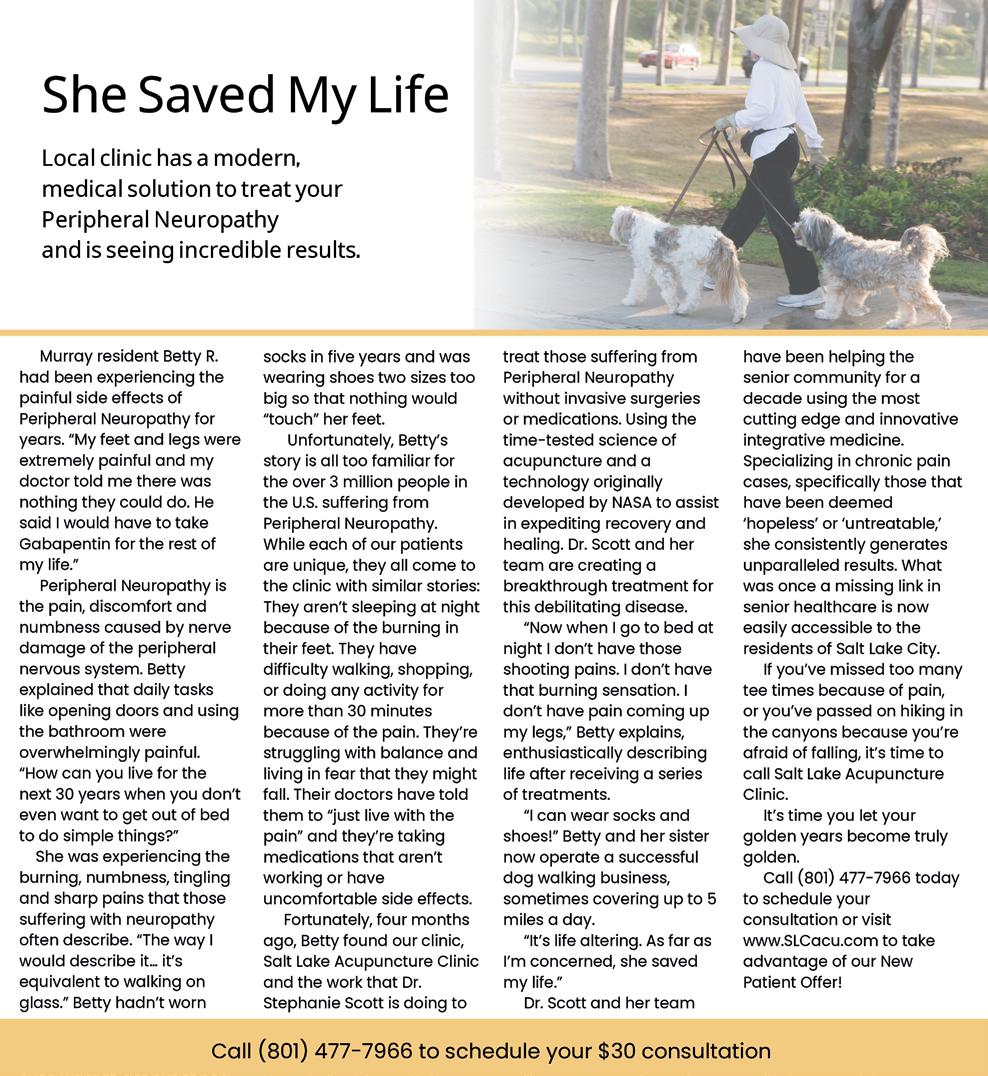

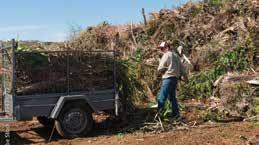
Canyons’ unified prom aims to create unforgettable night for students of all abilities.
By Julie Slama j.slama@mycityjournals.com
OnApril 30, more than 200 high school students are anticipated to attend the Canyons School District’s unified prom, where students of all abilities will enjoy a memorable evening of dancing and celebration.
Corner Canyon High junior Sasha Krull is one of the event’s organizers and is thrilled for her non-verbal sister, Savannah, a freshman, to experience some of the same fun moments she’s had.
“This is an event that’s a sensory-friendly prom,” Krull said. “Sometimes, a gen(eral) ed(ucation) prom has too much going on, it’s too loud. This is just something that is for them so they can have these experiences.”
As part of Corner Canyon’s Peer Leadership Team, Krull is helping plan the dance for Essential Elements Curriculum students, who follow grade-level alternate core standards designed for students with significant cognitive disabilities. The team is currently raising funds to cover costs for decorations, desserts, corsages, boutonnières, crowns and sashes for royalty, a photo station and more. Donations can be made at: https://sfnd.io/k78jp.
Corner Canyon special education teacher Kelsie Wilson said there will be alternative activities, such as balloon artists.
“We’re hoping to have more alternate activities as some of the kids don’t like to dance, but we all want to have a special night,” she said.
With The Ballard’s support, the venue for the event has been secured, and the students are also working to raise funds for its cleaning fee. Additionally, deejay Jason Gonzalez with
Sound Lab Utah is donating his services, and Chick-fil-A has agreed to provide box meals for the attendees.
The venue was chosen partly because of the option to convert the bridal suite into a sensory room, offering an alternative space for students who may become overstimulated by the event. While students are encouraged to dress up, they are also welcome to come in comfortable attire.
“At unified prom, some of the things, like wearing headphones, are part of its inclusivity; no one’s going to give a second thought,” Krull said.
Wilson added that many of her students will bring dates, likely peer tutors, and may also participate in a daytime activity similar to other high school dances.
The theme of the prom, “Core Memories,” will draw inspiration from emotionally significant memories that shape an individual’s identity and viewpoint. Corner Canyon’s PLT plans to incorporate colorful balloons to symbolize these “core memories,” inspired by the 2015 Pixar movie, “Inside Out.”
For Krull, the dance represents much more than just an evening of fun.
“After they graduate, a lot of the kids in these classes are going to go to Life Skills Academy and life is going to change a lot for them,” she said. “They won’t be with their same general education peers they know here at school, but with others at other schools.”
Wilson also emphasized the importance of this gathering.
“Because they’re all going to be mixed in with each other, this is nice to have a fun activity for them to meet each other and interact with each other before they go to school together,” she said.
Those interested in contributing in other ways can reach out to Kelsie Wilson at Kelsie.Wilson@canyonsdistrict.org for more information. l
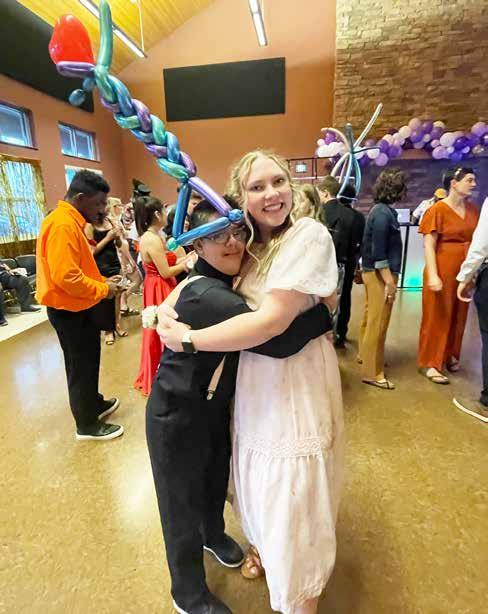
The Cottonwood Heights Journal is a monthly publication distributed directly to residents via the USPS as well as locations throughout Cottonwood Heights.
For information about distribution please email hello@thecityjournals.com or call our offices. Rack locations are also available on our website. The views and opinions expressed in display advertisements do not necessarily reflect or represent the views and opinions held by Loyal Perch Media or the City Journals. This publication may not be reproduced in whole or in part without the express written consent of the owner. © 2019 Loyal Perch Media, Inc.
PUBLISHER
Bryan Scott | bryan.s@thecityjournals.com
EDITOR
Travis Barton | travis.b@thecityjournals.com
ADVERTISING EXECUTIVES
Mieka Sawatzki | mieka.s@thecityjournals.com
Lindsay Andreasen | lindsay.a@thecityjournals.com
Jason Corbridge | jason.c@thecityjournals.com
Ryan Casper | ryan.c@thecityjournals.com
Marc Davis | marc.d@thecityjournals.com
Lydia Rice | lydia.r@thecityjournals.com 385-557-1022 Rack locations are also available on our website.

The quest to bring more of the hundreds of illegal short-term rentals into compliance continues with city council noting strict enforcement preferences from residents.
By Cassie Goff c.goff@mycityjournals.com
InCottonwood Heights, a sub-committee to examine the current state of existing short-term rentals (STRs) throughout the city and to research best practices for regulation and enforcement has been created. As part of this research, a STR townhall was held on Feb. 26 to hear thoughts and concerns from residents.
“The Ikon Pass put our canyons on the word radar,” said Councilmember Suzanne Hyland. “And the pandemic expanded world visitation. We have more visitors to the canyons than to Zions National Park.”
“There’s a lot of demand to operate these STRs in a city so close to these amenities,” said Community and Economic Development Director Mike Johnson.
Currently, there are 84 active (and legal) short-term licenses within the city. The majority of those 84 licensed STR units are within the Canyon Place Condos (near the mouth of Big Cottonwood Canyon) and Canyon Racquet Club Condos (7430 S. Wasatch Blvd.).
“Those who do it legally operate it as a small business and I think we do a good job,” said Jim Rock from the Canyon Racquet Club. “Those of us who do it the right way are proud of what we do.”
Within Cottonwood Heights, STRs are required to be part
of a private HOA or privately-managed community (and cannot be served by public streets). They are also required to be within multi-family zones or commercial zones. STRs are prohibited in single-family neighborhoods.
“STRs do not build a community,” said resident Brad Baker. “It’s going to cause problems because you don’t have neighbors when you have STRs.”
It is estimated there are around 350 to 400 illegal STRs within the city, based on current listings on various rental platform websites.
“These are operating well beyond where they are technically allowed to,” Johnson said.
Resident Eric Kirkam recommended the committee create a private setting for property owners to come forward. “Those who are in noncompliance … are afraid they are going to get caught. We have three older single ladies that STRs help with the incomes.”
In Cottonwood Heights, STRs are rentable for up to 30 consecutive days. (Rentals that extend beyond 30-days are considered long-term rentals under the city ordinances that have different regulations.)
“Rental companies are savvy on techniques,” said Cottonwood Heights Police Chief Robby Russo.
Russo shared how they have been seeing cases of fraud to get around this specific requirement. Rental owners are asking renters to sign 31-day contracts, so it appears as a long-term rental, to avoid litigation.
“We will continue to gather research with public input,” Hyland said.

city’s website at: www.ch.utah.gov
Then, navigate to the “City Services” tab, click on the “Community Development” title, and scroll to the “Short Term Rental (STR)” tab.
To see our previous coverage on STRs, visit the City Journals website at: www.cottonwoodheightsjournal.com
And search for the following article titles: Regulations for short-term rentals in the works STR Policy to get overhauled by City Council l























To learn more about STRs in Cottonwood Heights, visit the




























New art market hopes to make original art accessible to everyone.
By Collette Hayes c.hayes@mycityjournals.com
For over one hundred years, Pike Place Market has been known by many as the “Soul of Seattle” because of its vibrant art scene. Inspired by the Seattle-based market, in 1994, talented art curator Nanette Amis brought a little piece of the famous marketplace to Salt Lake City.
Amis’ Utah Art Market has popped up in various locations throughout Utah for over 30 years, including in her home and in her backyard. Finally, in October 2024, Amis realized the dream of offering her large, devoted clientele a full-time brick-and-mortar shop. The Four Lemons – Art within Reach is now home to the artwork of over one hundred thirty local and international artists and crafters.
Amis told the Journal she has no plans to throw fish over the counter as they used to do at the well-known seaside market in Seattle, but she definitely plans to provide art that resonates deeply with each customer and at prices accessible to most.
“I’m trying to reach out to the people that love original art and don’t think they can afford it,” Amis said. “A single mom came into the store a few weeks ago and fell in love with an original painting. Financially, it was simply out of her reach. The mission of Four Lemons is to make art accessible to everyone. I told her if you can pay toward it each month, I’ll hang on to the piece for you. I want to do everything I can to help people have an original piece of art in their home. It brings me so much happiness.”
The expansive 7,000-square-foot space showcases pottery, jewelry, woodworking, original paintings and prints, homemade jelly, woodcuts, fiber and wool arts, inviting all to explore pieces starting around $6 and with selections ascending to over $1,000.
Several well-known artists display their pieces at Four Lemons. Clint Whiting’s impressionistic realism art has received numerous awards and also “best of show” at events in New York City, New Jersey, Naples, Milan and Rome.
Oil and acrylic painter Tricia Cook’s simple, clean lines and balanced colors, shapes, and textures bring out the beauty in her simplistic artistic scenes and are easily incorporated into a home setting.
Sarah Winegar’s nod to the Byzantine period is evident in many of her inspirational pieces. Her relief woodcut prints of the Last Supper bring human figures together, flowing in unity, each with his own story to tell. The unseen feelings of the individuals are portrayed in the fine, detailed cuts in the wood.
Primarily, a botanical and landscape artist, Rachel Nelson has a large following of devoted collectors. She strives for an overall painting composition that combines the detailed
light and color techniques of realism and the loose brush strokes of impressionism.
Amis began collecting African art about 10 years ago. She wanted to promote emerging artists from developing countries as a humanitarian effort. She ordered handmade baskets from a family in Ghana. Also, she decided to contact Muramuzi John Bosco, a Ugandan contemporary artist based in Kampala in eastern Africa. Amis ordered 15 pieces of his art for the store. He shipped them from Africa. Amis framed and sold half of them.
In January, Amis and her husband visited friends who were living in Nairobi, her first experience visiting Africa.
"When I was in Nairobi, we went out for dinner one night at the restaurant where Muramuzi displays his art,” Amis said. “I had no idea Muramuzi would be there. He only comes to Nairobi twice a year, and I only visit Nairobi once in a lifetime. What an unbelievable coincidence!”
Muramuzi shared in a conversation at dinner that the proceeds from the art sales at Four Lemons has been used to build a Christian school for the children in his community. Now, every piece of his art that is sold, helps a student for one year.
How to become a Four Lemon’s art vendor Amis shares on her website that if you’d like to join the Four Lemons family, you are encouraged to apply for the Utah Art Market first. If your products are well-received by Utah Art Market customers, an invitation will be extended to showcase your work at Four Lemons.
“We offer many different services at Four Lemons,” Amis said. “We have people at our store who can help you hang gallery walls if you feel intimidated by creating a gallery or themed collection.”
Art is a powerful catalyst that brings people together, creating meaningful connections. It weaves the shared stories of communities, igniting reflection and encouraging dialogue. In the future, Amis envisions Four Lemons as a gathering place for small communities, including book clubs, art events, and various gatherings. The Utah Art Market will be held four times a year at the store, and art education classes will be offered monthly by Four Lemon artists.
“I love the idea of looking toward this becoming a place of community where people can gather to meet, connect and find common ground,” Amis said. “I think little groups of community could gather at Four Lemons to share interests. I am an inclusive person and I love nothing more than for people to meet artists and artists to meet collectors and artists to meet each other creating a space of community.”
The importance of collecting art
According to Amis, an original piece of art is timeless and something to be kept forever. She suggests not many material things


bought in a lifetime last and are special enough to be handed down from generation to generation. Art can be hung on a wall, set out on a table to be enjoyed, or given to someone else to enjoy their entire life, which Amis feels is the true beauty of art.
“When I was newly married, I couldn’t afford to buy original art. One Christmas, my brother David gave me a still-life painting that he had bought at Dolores Chase Gallery in downtown Salt Lake. The painting was of four lemons on a windowsill created by Rebecca Wagstaff. It was the first piece of original art I had owned. I was really taken aback by his giving me such a treasured gift. Knowing I now owned a piece of original art felt so important. Because this painting holds such senti-
mental value, I decided to name my store Four Lemons.”
For now, the painting of the four little lemons sitting on the windowsill can be found on the counter right next to the cash register. It extends a warm welcome to each patron who enters the store. Many years from now, when the store lights have dimmed, and the door whispers closed for the last time, the small four lemon painting will move on, finding a cherished place in the home of one of Nanette's children to love across the generations to come with a piece of art.
To learn more about the Utah Art Market and how to become a vendor, visit www. utahartmarket.com. l
Brighton spring sports are poised to dominate Region 6 and place at 5A state.
By Jerry Christensen j.christensen@mycityjournals.com
Ashort 12 months ago Brighton coaches and athletes didn’t quite realize they were on the precipice of finals appearance, individual and team state championships. It was a spring sports season marked by expected and somewhat unexpected highlights. This year, the expectations are set. Brighton’s trophy cases are due for another influx of state hardware.
Brighton Track and field under the seasoned leadership of Coach Kirk Merhish and Coach Jeni Hancey Larsen is a force to be reckoned with in Region 6 competition and at state. Senior Beau LeFleur, who helped take the football team to a final four finish at Rice Eccles Stadium in November, is back to defend his 2024 300-meter high hurdles state championship.
“I hope to add another championship in the 110-meter hurdles as well,” LeFleur said.
He is currently seeded No. 1 statewide in each of these events. He has signed with Snow College to play linebacker/ running back after graduation.
Bridget Smit, a Brighton ninth grader, was the fastest freshman in the Pocatello 2025 Simplot Games girls’ 1600 meters with a time of 5:07.20.
“Bridget, as a freshman, is very close to breaking the school record of 5:03 set by Lia Belle Selander (BHS ‘23) and the 3200-meter school record of 11:00 set by Caroline Rupper (BHS ‘22),” said Annie Selander, assistant team coach.
Other Brighton track and field athletes that are poised to have breakout years include:
Distance runners sophomore Easton Evers, senior Zac Engles and freshman Whittaker Bettis;
Sprinters freshman Judah Naweli and sophomore Sophie Crespin;
Hurdlers and jumpers junior Calvin Hawkins and senior Bryant Hill;
Throwers junior Jackson Nettleton, senior Marshall Huber and junior Audrey Kessinger.
“Not only are these athletes strong and fast, our team is primed for success because of their stellar attitudes of respect, work ethic and teamwork,” said head coach Kirk Merhish. “The first words out of these kids’ mouths are ‘Yes! Coach!’ This attitude shows me that no matter what this season brings, we can take it in stride and come out on top.” The first goal is to repeat as region champions.
Baseball
Brighton baseball begins the season as the odds on favorite to repeat as Region 6 champions and to win the 5A state championship outright. Coach Mark Kleven returns 14 players from the 2024 team that went 20-1 in region play and pushed to the finals in 5A state play.
“With the No. 1 preseason ranking in all state categories, we will have a target on our back all season,” said Josh Mawhinney, who just recently was named to the 5A academic all-state team in basketball.
He and seniors Miles Layton and Case Beames led the team in Arizona against top 20 nationally-ranked teams in mid-March to a 2-2 record. They begin the 21-game region schedule before making the run in the state tournament for
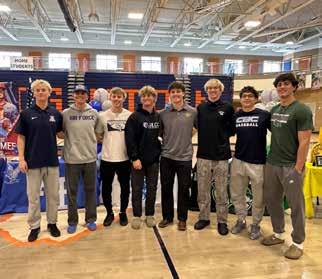
the first Brighton baseball state championship since the 1990s.
Seven of the team’s seniors have signed to play baseball at the next level:
Case Beames, University of Arizona
Miles Layton, Air Force
Easton Fry, College of Southern Idaho
Riley Brown, SLCC
Cooper Scott, College of Southern Idaho
Josh Mawhinney, UVU
JC Garza, Columbia Basin College
River Schmidt, Shoreline Community College
Girls Lacrosse
Brighton girls lacrosse is known for strong cohesion, large recruiting classes, top-four finishes in state and classic on-field dance parties.
“We are looking forward to another strong year! We’ve finished third in the state for four years in a row–since 2021 and are hungry for more,” said 11-year coach Melissa Nash.
This year’s entry is a very senior heavy team—10 seniors (12 players start on the field at once) who are experienced and motivated to win. The stated goal of the team is to play and win in the state championship at Zion’s Bank Stadium at the end of May.
The team had Adam Sear coach at the annual team retreat. Sear played for Team Australia and has coached the women’s teams at Notre Dame and Michigan. He most recently coached the first annual Women’s Lacrosse League (WLL—a professional league). Some players to watch out for: Caroline Lee, Sophie Nielsen and Marley Rodney. They have all been selected as part of the preseason All-American watch list which is a rare honor in Utah. Nielsen and Lee scored four points each in the home opener against 6A Mountain Ridge.
The team also returns stand-out goalie, Annabelle Keefer. She was an all-region and all-state goalie last year and had 10 saves in the first game.
The toast of all Brighton sports last year was boys lacrosse. While the state finals were reached by swimming, baseball and girls soccer, it was Coach Chris O’Donnell and the boys lacrosse team that brought home the state championship. Two of his returning state champions have already signed to play at the next level—Austin Taylor at Westminster College and Jaxon Webster at Gettysburg College.
The season last year was near perfect except for the last
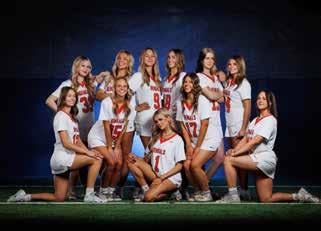
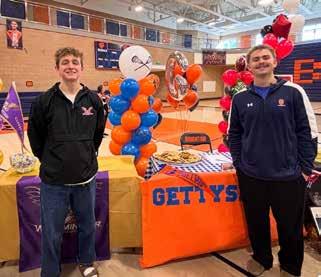
two minutes of the regular season. Rival Park City scored a goal that sent the game into overtime where the Miners gave Brighton its only season loss forcing Brighton to share the Region 6 title. The Bengals avenged the loss in the state championship game when the two foes met again and Brighton emerged as the state champion.
O’Donnell is clear on his preseason expectations to “compete in every game we play—win region and repeat as state champions.” The season has begun as outlined by O’Donnell. The team challenged itself in preseason against 6A teams and competed well. A highlight was a much anticipated match up of the 6A state champion Corner Canyon hosted by 5A state champion Brighton. Freestone Field lay under four inches of snow at game time and the contest was quickly commuted to Charger Field in Draper. With an 8-8 tie in the fourth quarter, Corner Canyon punched in two final goals that decided the game in their favor.
Barring any further snow, home games at Brighton to showcase the defending state champions will be:
April 22 vs East
April 29 vs Skyline
May 2 vs Highland
May 6 vs Mountain Ridge
May 7 vs West
Mid-May State Games TBD at Freestone Field l
Canyons middle school unified basketball teams learn skills, teamwork, sportsmanship while bringing joy and becoming friends off the court.
By Julie Slama j.slama@mycityjournals.com
Onthe basketball court, sixth-grader Wyatt
Shipp receives a pass from a teammate and takes the shot. The ball goes in, and a smile spreads across his face. His teammates, along with players from the opposing team, celebrate with high-fives.
“Basketball is my favorite sport,” he said. “I practice a lot in my driveway and with my friends on my team.”
Wyatt is part of Draper Park Middle School’s unified basketball team, where students with and without intellectual disabilities play together. The team was participating in the Canyons School District’s middle school unified basketball tournament.
Cheering from the stands was Wyatt’s grandfather, Doak Duncan.
“It’s thrilling to see the joy of these kids making baskets,” he said. “We didn’t know Wyatt was ever going to be able to do any of this. He’s got a very rare gene where he has low muscle weight, experiences a lot of seizures and has low retention. We weren’t sure he would be able to sit up or stand or even walk. It’s a miracle he’s playing basketball.”
Canyons School District Assistant Superintendent McKay Robinson appreciates the value of unified sports.
“Unified Sports are the absolute best,” he said. “They aren’t just about the game; they’re about breaking barriers, building friendships and teaching every student the true meaning of inclusion and teamwork.”
Wyatt’s coach, special education teacher
Morgann Collins, believes unified sports provide students with a chance to develop both sports and social skills.
“They get to be part of a sports team when they might not have the opportunity on, like a typical sports team,” she said. “They are excited for our basketball practices to learn how to play and to practice together. They came in this morning, screaming and so enthusiastic, saying ‘It’s game day.’”
Collins added it’s not just the athletes who are excited, but also the partners who support them.
“Our partners do an amazing job of making sure everyone is getting opportunities to shoot and involving everyone. They’re good to cheer on our own athletes as well as the athletes on the other team. This might be their first interaction working with people with disabilities, and as they’re transitioning to being older kids, they recognize they’re a partner and the game is for the athlete. And their parents are appreciating it as well. I had a parent of a peer tutor tell me that he’s super grateful his son had the opportunity to be part of this team and he was able to just witness the greatness of unified basketball,” she said.
The opportunities extend beyond the court, with the school’s Buddy Club offering a chance for students to sign up and eat lunch with peers in Collins’ classroom.
“They can go outside after they’re done eating lunch or they can play games they want to and stay inside. A lot of our kids are social, and the kids want to be friends; they don’t see them as students with disabilities, but as equals they want to hang out with them,” she said.
At Butler Middle, special education teacher and coach Noah Filzer said his team meets every Friday for lunch before practicing drills.
“Everyone is smiling because they’re comfortable with one another,” he said. “We’re building camaraderie as a team. None
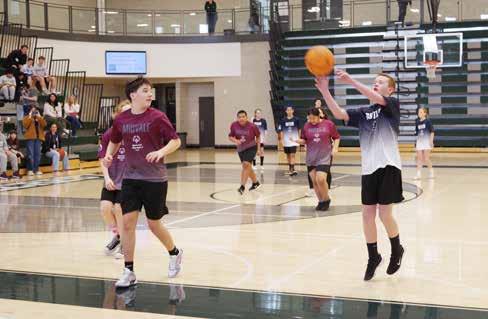
of them have the same classes since they’re all different grades, but they come together for unified sports.”
Filzer highlighted the inclusivity of the program.
“Anybody can participate so everybody has the equal opportunity to get out there and compete and have fun,” he said.
Eastmont sixth-grader Zacc Turner agrees, appreciating the experience of playing with friends.
“I like playing the game and playing with my friends,” he said. “We’re about to go up against my best friend’s team; I played with him last year at recess at Sandy Elementary. It’s just fun to compete and hang out with my friends.”
Zacc’s coach, career and technical education teacher Mark Snow, said some athletes were nervous at first, but their excitement grew as they played.
“Now, they’re all excited and having fun,” he said. “This means everything to these kids. It’s fun to watch them play together as a team. It was a big deal for them to represent Eastmont. They love picking their jersey numbers.”
Since basketball was a new skill for some students, the team practiced daily for 45 minutes starting in January.
“We taught them how to dribble and do layups. We talked about sportsmanship and to have fun. You don’t always have to win to have fun when you play sports,” he said.
Canyons Board of Education member Karen Pedersen saw the sense of community and inclusivity firsthand when an opposing team member helped push a player in a wheelchair just to include them in the game.
“It’s fun because they’re really friends out on the court,” she said. “Many students want to know each other. The focus isn’t on winning and losing. It’s everyone having that opportunity to succeed and be seen — and support
one another.”
Midvale Middle School students also appreciate the camaraderie.
Eighth-grader Jose Dina said when he got the ball, he shot it.
“I threw it right up there, and it went in,” he said. “Then I got a high-five afterward.”
Seventh-grade partner Emily Wallace said cheering is an important part of unified sports.
“I like to cheer people on; during practice when we divide our team and play each other, I get asked why I cheer and I tell them because we’re all doing great, and in the end, we’re all on the same team,” she said. “Even here, I’m cheering on everyone. I want everyone to do well.”
Emily often leads the cheer after each game with a loud “unified!”
Midvale healthy lifestyles teacher and coach Katelyn Parry said her team focuses on encouragement.
“Our aim is to have fun and encourage each other, whether it’s our own team or the other team,” she said. “Everybody’s here for the same reason, and it’s to play and be part of something bigger than just our school. This is a great opportunity for our students to meet new friends, learn some skills, participate in such a huge community event and be supported by peers and parents. It’s awesome.”
Canyons Board member Jackson Lewis watched several games and appreciated the positive environment the students were creating.
“I’m appreciating how the students together are creating positive environments for their teams,” he said. “It’s great some of these partners are passing the balls so everyone gets an opportunity. You can see the looks on these kids’ faces when they shoot and they score, and when they get the support from their fellow teammates, they’re loving it. This is an incredible inclusive community.” l

By Dr. Alex Drake
At CommonSpirit Health, our vision is a healthier future for all – inspired by faith, driven by innovation, and powered by our humanity. This extends to all the care we provide our patients, whether it be in our doctor’s offices, our clinics, or our hospitals.
We want your visit to our care sites to be as comfortable as possible, and we know that visiting the Emergency Department (ER) is difficult for any patient and their loved ones. I would like to share some information about what to expect in the ER, so that you can be as prepared as possible.
Our emergency caregivers are here for you 24 hours a day, 7 days a week, 365 days a year to serve our community. We accept all patients – regardless of insurance status or ability to pay. A typical visit to the ER can take two-to-three hours, but please know that in the ER we must evaluate and treat our patients based on severity of their condition. This might mean longer wait times in the lobby or even after being placed in an exam room. However, this also means that if you’re having a life-threatening emergency, you will have the undivided attention of our doctors and nurses.
If you have mild-to-moderate symptoms – such as fever below 103 degrees without a rash, flu-like symptoms without shortness of breath, or sprains and strains – you may wish to consider calling your primary care provider or visiting an urgent care center, as these options may be faster and are often less expensive.
Symptoms or health issues that require immediate medical attention may include the following:
• Chest pain
• Sudden weakness or trouble talking
• Difficulty breathing
• Spinal injuries
• Severe head injury
• Major broken bones
• Major burns
• Sudden change in vision
• Heavy bleeding
• Large open wounds
You should never drive yourself to an ER if you are having severe chest pain, severe bleeding, if you feel like you might faint, or if your vision is impaired. When in doubt, please call 911 — what matters most is that you get to the emergency room quickly and safely. If you arrive by

ambulance, you will be triaged and we will determine the level of care required.
All emergency physicians at CommonSpirit Holy Cross Hospitals are board certified in Emergency Medicine and have trained for many years to help you in your emergency. The doctors also have specially trained midlevel providers who can also help. Your provider may order tests like X-rays, CT Scans, Ultrasounds, bloodwork, urinalysis, an electrocardiogram (EKG), or others, depending on your health problem.
After receiving test results, the doctor will discuss the findings and diagnosis with you. If needed, they will advise admission to the hospital. If your condition does not need admission, they will give you written instructions about treatment to be followed at home. This may include prescriptions, tips for home care, and any referrals needed for following up with either a primary care or specialized doctor.
While we hope for the health and safety of those in our community, know that we are here if you need us. Our excellent doctors and nurses at CommonSpirit Holy Cross Hospitals are ready to provide high-quality, compassionate, and timely care.

As CommonSpirit Health, we make the healing presence of God known in our world by improving the health of the people we serve, especially those who are vulnerable, while we advance social justice for all.

The right ER. Right around the corner.
When you need emergency care fast, the closest emergency room is a smart thing to know. You never know the level of care you’ll need when an emergency happens and choosing the right ER can make all the difference. And a hospital ER comes with the confidence of additional services right on-site.
Find emergency care close to you at mountain.commonspirit.org.
Health Mountain Region does not discriminate against any person on the basis of race, color, national origin, disability, age, sex, religion, creed, ancestry, sexual orientation, and marital status in admission, treatment, or participation in its programs, services and activities, or in employment. For further information about this policy contact CommonSpirit Health Mountain Region Office of the General Counsel at 1-303-673-8166 (TTY: 711). Copyright © CommonSpirit Health Mountain Region, 2025. ATENCIÓN: Si habla español, tiene a su disposición servicios gratuitos de asistencia lingüística. Llame al 1-303-673-8166 (TTY: 711). CHÚ Ý: Nếu b
(TTY: 711).
Local high school artist Chloe Horton’s “Overgrown” captures the beauty of a forgotten grave, wins a top honor at Springville Art Show.
By Julie Slama j.slama@mycityjournals.com
The 53rd Springville Art Museum AllState High School Art Show featured 327 pieces of art selected from more than 1,000 submissions and one of the standout pieces was “Overgrown,” a painting by Chloe Horton, which depicts an angel statue near a grave, its headstone overtaken by lush green vines and flowering bushes.
Horton completed the painting just before the submission deadline in January.
“It was 10 minutes before deadline,” Horton said. “I was working on it for a while. I started the initial sketch on Nov. 13, then over the course of a few weeks, it started getting more and more built up. It’s the first watercolor I’ve ever finished. Once I submitted it, I got a call from Springville, and my first thought was that something went wrong.”
The Brighton High School junior was pleasantly surprised by the news.
“When I answered, they said, ‘Congratulations,’” she said. “That really caught me off guard. It’s an honor to be a part of Springville show and to win the Third Congressional District Award. It means ‘Overgrown’ will go to (Washington) D.C., for one year, and be displayed in the U.S. Capitol.”
This is Horton’s first piece of artwork to win a contest.
“Well, in first grade, I did this painting of cat tails with a butterfly on it, and I guess it won something because it got framed at my elementary school in South Carolina,” she said.
Her Springville painting highlights a neglected headstone, often overlooked by many.
In her artist statement, she writes: “The piece represents the fear of death more specifically the fear of being forgotten. I created this painting with the purpose to show that death really isn’t so scary. The tomb is ‘Overgrown’ surrounded with plants and weeds. Mother Nature is caressing us with her loving hands helping us through this transition. And there we lay grounded, to our original roots. Even though we die, everything around us continues, the sun still shines, the birds still sing, the flowers will still grow. I find comfort in that. I find it beautiful the way it all intertwines. And that we will all eventually be forgotten, and as scary as it is — it’s all gonna be okay. the way the grave is etched covered in moss leaving the name indistinguishable from our view. But in a way that’s just as beautiful as the flowers that grow alongside it.”
Horton was inspired when she saw a photo of the statue at Highgate Cemetery in London.
“I had to do a project for my AP (Advanced Placement) art class where we had to make an intricate and detailed painting. I was just searching, and I stumbled across this, and it really caught my eye,” she said. “I’ve always been really into symbolism, and I want to create something beautiful with it. It really inspired me, this beautiful statue with this grave that you couldn’t see the name on it. It eased the fear of being forgotten in society once you pass away.”
Horton’s love for art began as a young girl.
“I always doodle during class and sketch,” she said. “When I got my first iPad, I downloaded an art app to get art lessons and that taught me how to do things like how to draw proportionally and shadow and draw things more intricate.”
Even before that, when her family was moving, she found inspiration to create.
“The story goes that my mom was packing when I was little and so to keep me busy, she just handed me a pen and a piece of paper. When she showed me how to draw with it, I was in awe, with my jaw open, like I found the Holy Grail. I really liked fashion then, so I’d draw dresses, even my dream wedding dress. I also really liked drawing flowers like hibiscus and beaches around me in South Carolina. I would always include people. I love drawing their eyes and faces and even their clothes on people, like my own little models,” Horton said said.
That love for drawing people turned into a passion for portraits as Horton grew older.
“I love capturing emotions. I like drawing the faces of strangers and show how I see them, without worrying about being perfect. Art almost calms my mind. I’m a sporadic person, kind of bouncing off the walls. I’m not really an anxious person, but I can get in that mind space, and when I just draw or paint it quiets my mind a little and makes me find joy and comfort and things don’t seem so strange and overwhelming. Drawing, in a way, is like piecing parts of what’s around me, and simplifying it so it’s not so complicated, into faces or landscapes. I’m not as good at landscapes, but capturing expression and their essence on faces is satisfying to me,” she said.
At Brighton High School, Horton has enrolled in various art classes—drawing, ceramics, jewelry and AP art—and she has dabbled in embroidery. Yet, painting remains a passion.
“Overgrown” is primarily watercolor, but she added fine details with colored pencils and painted highlights with watered-down white acrylic.
“When I get an idea, I begin on sketching. I use circles and lines, and
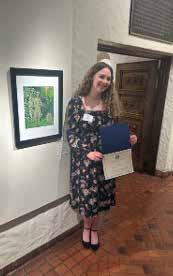

When I get an idea, I begin on sketching. I use circles and lines, and then I cut out the negative space. Once I’m done rough drafting, I go on with the finer details, and then I block out the colors and add highlights and shadows and finishing touches. Even so, when I have a fresh blank canvas, it’s really daunting to put the first pencil stroke down.
Chloe Horton
then I cut out the negative space. Once I’m done rough drafting, I go on with the finer details, and then I block out the colors and add highlights and shadows and finishing touches. Even so, when I have a fresh blank canvas, it’s really daunting to put the first pencil stroke down,” she said. “I’m still
developing my style and getting more confident with my brush strokes, and my overall line work. It’s soft and pretty, inspired by the paintings of the late 1800s and then maybe some of the 1700s. The way they did colors and values in those old pieces of art are really beautiful.”
With the success of “Overgrown,” Horton is looking to create more paintings exploring similar themes.
“I’m starting to take art seriously as a career and I’m actively improving my portfolio creating cohesive pieces. I like the concept of time and how quickly it passes, and how we need to save what we have left and make the best of it out of it. There’s a lot I can do with that theme,” she said. “I used to think of being a curator at an art museum, so I’d pick pieces for collections, and guide people around and talk about the art. I didn’t want to do art as my job; I worried about losing my passion. Now, I’m more confident in my skills and I’ve realized I wouldn’t lose my passion, so I’d like doing art as my future job.”
Horton hopes to travel to the U.S. Capitol with her family to see her painting on display.
“I like seeing how other people perceive my art, how it can impact someone and how they could interpret my art into their life, into their experiences,” she said. “That is so beautiful; it’s the best part of being an artist.” l


By Julie Slama | j.slama@mycityjournals.com
Ninth-grader Julia Ashby, of Riverview Junior High in Murray, wanted to explore AI and ChatGPT while Hadley Miller, a Draper Park Middle School student, was looking into college chemical engineering programs. Callyn Mortensen, a ninth grader at Sunset Ridge Middle School in West Jordan, was discovering more about coding and freshman Chelsea Baker, from Brighton High in Cottonwood Heights, was investigating various technology-related careers at the event.
These students were among the 3,000 girls from ninth to 12th grade who attended SheTech Explorer Day, an event designed to introduce girls to the world of technology in a fun, engaging atmosphere. During the event, they had the opportunity to meet STEM role models and discover a wide array of opportunities in the field.
Throughout the morning, girls from high schools across the state participated in more than 40 workshops focused on topics such as programming, engineering, aerospace, robotics, product invention, entrepreneurship, biomedicine, digital marketing, web design and gaming.
In addition, they had the chance to experience the interactive TechZone, where local STEM companies and educational institutions provided opportunities to learn about internships, programs and industry experiences.
The day wrapped up with a collaborative small group exercise in which the girls worked together to brainstorm, innovate and pitch solutions in a TechChallenge, all while being guided by industry mentors.
Students learned about the event through fliers posted at schools, emails from counselors or by hearing from teachers in various classes ranging from interior design to computer science to manufacturing technology.
Hailey Derr, a ninth grader at Cottonwood High in Murray, wanted to explore
biomedical engineering careers, so she visited her career center and discovered the event was a good opportunity. She’s already planning to take medical terminology and medical math next year.
Reagan Fairchild, a ninth grader from Sunset Ridge, was learning “how they keep patients safe during surgery and other cool things in the medical field” as she explored the TechZone.
Sydney Birk from Draper Park Middle School had just finished astronaut training.
“I was clicking a button to spawn an object and grab it or flick it to a target; if I hit the target, it gave a score,” she said. “It was fun. I want to be an astronaut and this is better than online simulations.”
Rylee Blackwell from Hidden Valley Middle School in Bluffdale was trying out Alexa glasses.
“I like how you can hear music and nobody else can,” she said. “I was in my own little world while there’s so many people here. It was relaxing.”
Retired electrical engineer Shari Mann demonstrated how to use the Alexa glasses with built-in microphones, offering a hands-free experience.
“I'm really passionate about inspiring girls to go into engineering,” she said. “I like how excited the girls are to try on the Alexa glasses and not just learn how they work, but understand it.”
Mann’s father encouraged her to pursue engineering back when there were “just a handful of females studying engineering” at the University of Texas in the late 1980s. She has since programmed microchips and holds patents in the field.
“I always say, engineers invent the world, and we need all different kinds of people represented in inventing this world; it’s a great career and it’s been fun,” Mann said.
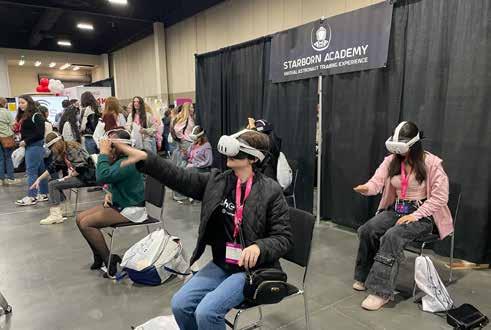

By Julie Slama | j.slama@mycityjournals.com
Every year, just around Mother’s Day, Entrada High School hosts a plant sale, offering a wide variety of plants “dirt cheap.”
Patrons can find packs of Roma, cheery, and large tomatoes, as well as sweet and hot peppers, often selling for just a few dollars. There are also herbs like basil, parsley, oregano, rosemary, and others, along with geraniums and coleus.
These plants, and others sold at the event, provide valuable hands-on training for adult students working toward their high school diploma or GED, while also earning science and elective credits. The proceeds from the sale are reinvested into the program, buying supplies for the next year.
The botany-greenhouse program has been running this way since teacher Anita Leimbach and community education facilitator Cheri Prince took it over in 2014 after the previous instructor retired. While Prince now helps coordinate the sale, David Dau joined as the new instructor four years ago.
“These students learn how to be responsible,” Leimbach said. “One student could screw up hundreds of plants in 20 minutes if they don’t listen to directions. The sale from last year gives us the money to buy the soil and the pots for this year. So, they're all trading on last year's good students.”
In early March, the class was transplanting coleus into larger pots. Three teenage boys worked side by side.
Senior Sajjad Alsarifee, who hopes to grow a lawn in his yard, explained transplanting is important. His friend, junior Mohamed Hameed, said it helps the roots spread out.
Junior Khalid Khudair explained: “The roots are too smashed in together; when they germinate, you have to make sure they have space to live in. Being compact isn’t good.”
The boys came to Entrada for different reasons, none of which involved becoming botanists.
“I came because I wanted to get my credits finished faster and I can test out of classes,” Hameed said. “I’m getting science credit and it’s hands-on, which makes it more fun than some other classes. I like that we give back to the community when they buy the plants. It provides students more opportunities.”
Khudair, who had missed 1.5 months of class while on a vacation, was catching up on credits, while Alsarifee admitted he had skipped class his sophomore year.
“I always had something better
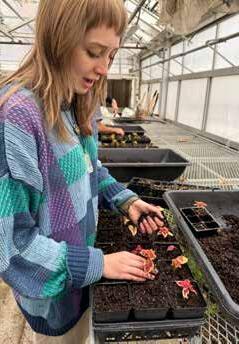
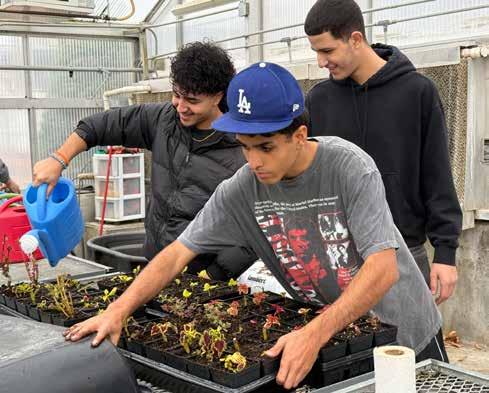
to do, like walk around,” he said. “I’ve made up a lot of credits here.”
Leimbach said her students come from a variety of backgrounds, including those who speak English as a second language, as well as students who are homeless or autistic.
“This is a rewarding class for many of our students. We’ve had students who excel in this who don't academically because it's hands-on; that's the difference. Everybody can do it, and some of these are smart kids. It just does my heart good to see these kids who have struggled to do so well. It’s the beauty of this program. They see progress and get to see projects completed. They come and see the plants remembering they may have transplanted them or made cuttings and now they’re in bloom,” she said, adding, “Some of them never even knew where a tomato came from.”
Typically, about 15 students attend the class twice a week for two hours. The course lasts about a month and counts toward the 24 credits Entrada students need for graduation. Currently, most of the 800 Entrada students are between the ages of 17 and 20.
“We have at least one botany class every session. Dave often will do it in the summer. Then come January, we offer two classes till May, which is more than we’ve had in the past. They always fill up,” she said.
Junior Jade Shafer-Pedersen has taken the class five times.
“I love this class,” she said. “It just gives me an outlet for creativity and it’s a personal connection between me and the plants. It just gives me a sense of peace in my school day, it's a nice safe space. I’m proud of these little guys for growing. I've learned so much from this class. I've only really grown house plants before and now, I’ll probably play with plants for the rest of my life. Anita and Dave are good teachers. They let us do our thing and then help us when we need it.”
When Shafer-Pedersen came to Entrada, she had “zero credits.”
“I never went to high school before. When the whole COVID virus happened, everyone went home from school, and I never went back. I never stepped foot in high school,” she said. “I never thought I would come back until I tried Entrada. I love it here. It’s so different.”
After finishing transplanting, Shafer-Pedersen and the others asked if they should remove the growth from the geraniums, deposit old soil and move the bags of new soil into the greenhouse.
“That's another thing I like,” Leimbach said. “They say, ‘Should I do this? They know what needs to be done and take that initiative. They care about the plants and the program.”
The program has blossomed over the years. It’s no longer just rows of plants in the greenhouse. In a portable classroom under lights, 4,000 plants are growing. By the time the sale comes around, there will be 2,400 tomatoes,
3,400 squash and cucumbers, and 2,000 peppers, in addition to geraniums, coleus, and house plants.
“When Dave was hired, he brought it to another level. He built the grow stations, and they germinate better there than the greenhouse because we could keep them a steady temperature. Then we bring them all over to the greenhouse. He’s also done hydroponics in the winter in the classroom, so the students are learning about that. Every year we learn to make it easier, so students can have a lot of success, and we get better results. He’s taken it to a more scientific level where I come from a gardener perspective,” she said.
Dau not only helps with the 10,000plus plants at Entrada, he has set up a 3,000-plant sale at nearby Jordan Valley, a school for students that have severe multiple disabilities including autism, cerebral palsy, traumatic brain injury, seizure disorders, communication impairments, genetic disorders and syndromes, deaf–blindness and, for students who are extremely medically fragile.
He also runs a business from home, selling about 1,500 plants.
“Once we set the expectations for the class, everyone realizes the relevancy. They learn how to set up the greenhouse, how to plant with healthy soil, how to water correctly, how to work as a team. Anita helps them understand the importance of the plants and the process; I’m the mad scientist,” said Dau,
who has taken Utah State University’s master gardening class three times as “there’s always something new to learn.”
The former school principal said students get dirty in the self-sustaining program.
“They’re learning how to propagate plants, transplant them into pots, grow lettuce and kale in hydroponics using a water-based nutrient solution rather than soil, they’re learning that a controlled atmosphere and soil temperature has helped growth, so they’re learning the science behind it,” he said. “They’re understanding plants and what they need.”
He explained students gain confidence by realizing they can grow plants without killing them, that asking logical questions will get them answers, and that giving plants attention is key to their success.
“Growing plants is part art and part science. For many, this is outside their comfort zone so they’re learning to work in teams as they learn new skills and vocabulary, to take direction and work with others, to be resilient and to appreciate a job well done,” he said.
Working with some of his immigrant students has led Entrada to grow plants native to their homelands.
“Some of them are really excited they can grow plants in their apartments that are important to the foods of their culture,” Dau said.
This has also expanded the variety of produce grown. The program typically grows 36 varieties of tomatoes, six varieties of hot and sweet peppers, six annual herbs, six perennial herbs, and four types of basil.
Through the plant sale, Dau said the community doesn’t just come for “cheap plants.”
“It’s building a community for students. We aren’t a traditional high school where you rally around a sports game or a performing arts performance. We’re providing goodwill for the community and they’re providing support for our students.”
Continued from front page
Jenny Curtis, Jordan School District’s work-based learning assistant, said the opportunity is incredible for girls.
“It’s cool, just to see all of these industries here, providing support and information and bringing all of these wonderful, mostly ladies, in tech,” she said. “It’s an amazing opportunity for girls to see what's happening in the field.”
Eileen Kasteler, Brighton High’s workbased learning facilitator, has brought students to the event for years and appreciates the event’s accessibility.
“It’s astonishing that a professional event of this caliber is free to girls year after
By Jet Burnham | j.burnham@mycityjournals.com
Antelope Canyon Elementary third-grader Lucas Ellis has been dealing with leukemia since 2023, with treatments, hospitalizations and medications, but one of the hardest things about the experience for the happy and social kid has been missing school.
“He has always been a very social kid— he thrives in having those interactions with his friends,” his mom, Marcela Ellis said. “When he first was diagnosed, we did a lot of online classes, which were helpful, but we could see that his emotional well-being wasn't being taken care of as well as we wanted it to be.”
When Lucas’ illness relapsed in January, his teacher Megan Dotson stepped into action to create ways for Lucas to remain connected to her, his classmates and the classroom.
She made T-shirts with Lucas’ signature smile and blue glasses which all her students and those in Lucas’ two siblings’ classes, as well as staff members and parents wear each Friday (which Dotson calls Lucas Friday.)
Through a foundation called Monkey in My Chair, Dotson arranged for a lovable stuffed monkey to sit in Lucas’ seat when he is not able to come to class. Students tote the monkey with them to the library, lunch and PE class, and send Lucas pictures of his adventures to help him feel included.
“We love getting the pictures of George the Monkey playing in the parachutes, or going to recess or at lunch—he loves it,” Ellis said. “What he considers the fun, the ‘not school stuff,’ he doesn't get to be part of that, so getting the pictures of the monkey and the letters describing all those things— he loves it.”
Dotson said the monkey sitting in his chair has helped students not forget about Lucas.
“Putting him in our room, it honestly feels whole again,” she said.
Students also stay in communication with Lucas by sending notes to him through a class mailbox. Dotson said she always emphasizes kindness and inclusion in her class-
year,” she said. “I like how the student ambassadors greet new girls, making it personal and welcoming.”
Gretel Diederich, a junior at Alta High in Sandy, completed her first year on the SheTech student board.
“I like the program and wanted to keep it going, so I thought the best way was to be an ambassador and support it,” she said. “I like exploring the booths and love talking to all the people to learn about all the programs I don’t know about. I also really love the girls. I made friends two years ago, and I still talk to them when I see them here. It says a lot about the SheTech community and the people.”
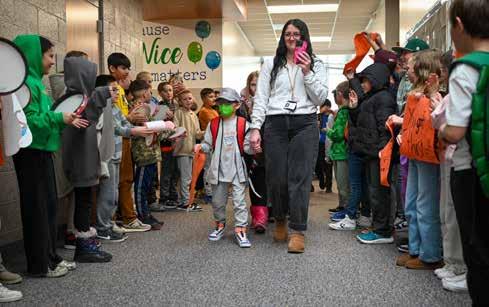
room but the last few months have given her students opportunities to put those values into practice.
“I've watched the empathy in each of these little kids grow by a million and a half,” Dotson said. “They just talk about it all the time, how excited they are for Lucas Friday, or how they're going to grab an extra this or whatever at home to put in his mailbox, or things like that. And just watching them care for someone else has been really, really cool, and then come up with ideas of how we're going to, or what we're going to say, or what they'd like to do to show him love. I encourage that a lot in this room, but I have watched it grow tremendously in the last little bit.”
Dotson comes to Lucas’ home to work with him regularly. She also visits him when he is in the hospital. Lucas said all the support from his teacher and classmates feels “awesome.”
Ellis said the support has been incredible.
“It makes him feel like people are there,
She was joined by her sister, freshman Leslie, who appreciated the event's schedule of workshops, and Alta High junior Audrey Semler, who was enjoying engaging with industry experts and participants.
“I love the energy here; everyone is having fun and it’s easy to talk to everyone,” she said. “I learned about different organizations for internships and college programs and scholarships.”
Kaitlin White, a freshman from Brighton, was eager to explore the booths at the TechZone, where girls could try several interactive activities as well as sample a new Coca-Cola flavor to checking out a Cybertruck. They could even test angular
even if he can't see them and if he can't hang out with them, people are there for him,” she said. “It's made a huge impact on his well-being emotionally. We noticed that when he is in a good mood or in a good emotional state, he recovers from the chemo or the procedures a lot quicker than when he's sad or feeling a little bit depressed.”
She said it was such a relief when Dotson took the initiative to arrange the zoom calls and the plan for keeping Lucas up with his classwork.
“That was a huge burden that she lifted,” she said. “As a family, we were worrying about all these other things that we had to do—his medication, finding a donor—all of it—and to not have to worry about that was just incredible.”
At the end of February, Lucas received a school-wide superhero’s farewell as he left school to prepare for a bone marrow transplant, which will keep him out of school for at least a year.
momentum.
“I find STEM stuff interesting, and I want to learn what I can do in the future in a tech career,” she said. “I also want to be a sci fi author so this definitely helps with that.”
Near the area where robotic cars were being driven, Riverview Junior High ninthgrade students Lexie Nelson and Aubrey Clayton were experimenting with InstaSnow.
“There's so many more careers than I thought there would be here; it’s awesome,” Clayton said.
Nelson added: “It’s all fun; I love the women empowerment.”
From industrial design to marriage and family therapy, students learn the pros and cons of the careers and what classes they need to take to prepare them for jobs.
By Julie Slama j.slama@mycityjournals.com
Butler Middle student Cassie Hager couldn’t wait for a classroom door to open.
“This is my dream career,” she said, pointing out that an exotic veterinarian was to speak. “It’s interesting to learn all about the different animals, their scales, their feathers, their fur. It would be fun.”
She, and other eighth-graders, rushed the door once it opened, eager to hear from veterinarian Scott Echols, one of about a dozen speakers who came to share about their jobs at the school’s career day. They ranged from industrial design and pediatric gastroenterology to mechanical engineering and a marriage and family therapist.
Through the presentation, students learned veterinarians are in high demand and not only work in clinics, but also aviaries; zoos; aquariums; with the police and military; in the wilderness with endangered species; in space with rodents; in labs, researching and developing medications for treatments; and many other areas.
“A lot of our time is spent understanding animals’ behavior so we can make sure we interact with it properly,” he said. “It helps us know the nature of a problem. Not everything is due to a medical issue, such as a wound or infection; sometimes they’re purely behavioral disorders.”
Echols intermixed stories of precautions taking care of venomous snakes to perils in Peru taking care of animals. He told how snakes are important part of the ecosystems, how bee colonies are collapsing and the work that is being done to treat bees, how pigeons provided courier service during World War I, how animals, including cows, can transmit bird flu to humans – and more – all while stressing the taking of STEM classes to pursue the field.
He answered questions about treating an octopus, sharks, rhinos, bees, scorpions and others, but the highlight of his talk, for many of the students, was seeing the shorttail python, an indigo snake, a red-foot tortoise, an alligator, a scorpion and other critters that he and a selected student took around the classroom so others could see. Cassie was asked to take around a plated lizard which nestled on her shoulder.
“I love going to work, because to me, it’s not even work. It is something I love to do,” Echols said. “Whatever it is you do in your future, make sure it’s something you
love to do. I don’t care if it’s in finance or if it’s teaching or this or that. Make sure you love it because then it’s not a job. It’s something that you love, something you enjoy.”
“I love how he implemented the importance of STEM in his career,” science teacher Erin Hemingway said. “He was inspiring for many of the students. It’s good they’re learning about possible STEM careers now because they will need to start to pick their classes for next year and look to take AP (advanced placement) and advanced science classes.”
School counselor Kayse Amevor said students rotated through three speakers, who gave them the overview of their professions, and often included the pros and cons of the career along with the education required and salary information.
“We asked students to write down two things they observed and one question they had about a career,” she said, indicating often students’ questions got answered at the end of every speaker, which kept them more engaged. “The kids are talking about this and seem to be interested in a number of careers that are being shared today.”
Across the hall from the veterinarian was Nathan Strong, who was talking to students about cell therapy.
“Millions of people in the country have back problems and that’s one of the things we’re helping to resolve,” he said. “As you get older, discs start to compress and it puts pressure on your spinal cord, which causes a lot of pain.”
Strong said through allogeneic cell therapy, cells are transplanted from one person to another, similar to organ transplants.
“We’ve already gone through phase one and phase two clinical trials, where the biggest adverse events that were reported was soreness of the injection site; there were no complications,” he said.
This would be a more economic as well safe alternative to back fusion.
“Back fusion is extremely painful and takes several months to recover, plus super expensive. We’re hoping to give people relief for two years or more, because our studies are still ongoing, at a much lower price,” Strong said.
Down the hall, Eddie Clayson, director of maintenance at Salt Lake International Airport, talked to students about overseeing maintenance crews, snow removal and security systems as well as other jobs at the airport.
“There are more jobs at an airport other than a pilot or a mechanic; Most of them, you have to graduate high school, but there’s anything from medical positions to firefighting,” he said, adding that the operations department works with the wildlife biologists to keep bird nesting
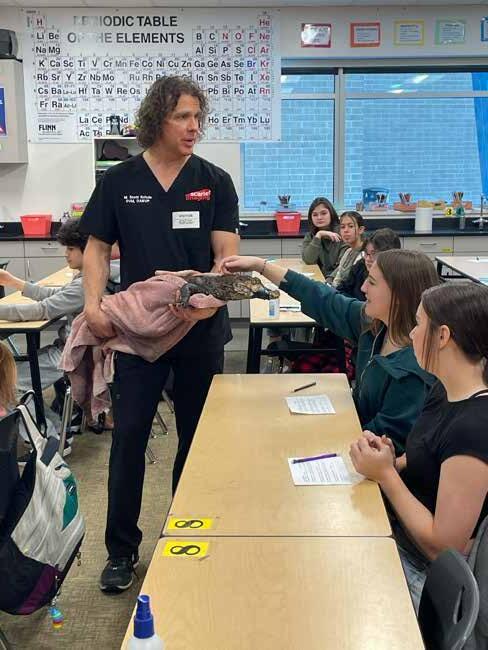
away from the airport. “Remember when Donovan Mitchell and Jazz hit the pelican (in March 2021)? That pelican was way high. We work on the habitat so that they don’t want to be there, don’t want to migrate there.”
Part of Clayson’s job is to oversee the nine miles of baggage system conveyors, which grew when the airport expanded.
“Everyone wants their bags, so we make sure it’s working,” he said.
Students inquired about the safety of flying after three recent plane crashes — a mid-air collision above the Potamic River in Washington D.C., a medical jet in Philadelphia and the regional plane which flipped upon a fiery landing in Toronto — and how it impacts airport operations.
“Planes are super safe, but stuff does
happen. After that, in general, people get nervous to fly although we haven’t seen any decrease. If we were to have a plane crash at our airport, it would shut runways down for a while, and that does affect us, because during that time, people aren’t flying, and they’re losing money because they can’t get to where they need to be,” Clayson said.
He said in the 31 years working at Salt Lake International, the worse accident he recalled was a plane sliding off a runway, with no injuries.
“We’re working hard to keep everything safe and to help people get to where they need to be,” Clayson said. “There’s a lot of people working together at the airport to make it happen.” l
Eight athletes from four winter sports earned the state designated academic all-state.
By Jerry S. Christensen j.christensen@mycityjournals.com
Brighton High School administration believes that extracurricular involvement plays a pivotal role in a student’s holistic development.
“We actively encourage our students to participate in the diverse range of extracurricular activities that we offer,” said longtime vice principal Justin Pitcher. These activities are designed not only to enhance their academic performance but also to equip them with essential life skills that will serve them well beyond their high school years.
Through participation in clubs, sports, and other extracurricular activities, students learn the importance of effective time management, as they juggle their academic commitments with their extracurricular pursuits. They develop strong communication skills through interactions with their peers, coaches, and mentors. They also learn the value of teamwork and collaboration, as they work together toward common goals. These skills – time management, communication, and teamwork – are highly sought after by colleges and employers alike.
By actively participating in extracurricular activities sponsored by UHSAA (Utah High School Activities Association), students are essentially investing in their future, Pitcher said.
“They are developing the skills and competencies that will prepare them for the rigors of higher education and the demands of the workforce. They are learning to be responsible, organized, and proactive – qual-
ities that are essential for success in any field,” Pitcher said.
After each sports season (which correlates with each of Brighton’s academic trimesters), UHSAA recognizes senior varsity athletes who maintain high academic standing (top grades) while participating at the highest levels of the student athlete’s chosen sport. Typically only 10 students per sport across the 30 high schools that are classified as 5A schools qualify for the designation of Academic All-State.
For winter 2025, eight Brighton student athletes earned said designation:
Sam Pehrson- Cheer
Drake Doyle- Boys Swimming
Cosette Arnoldsen- Girls Basketball
Amy Nye- Girls Swimming
Britta Nielsen- Girls Swimming
Emma Henderson- Girls Swimming
Creighton Evers- Boys Basketball
Josh Mawhinney- Boys Basketball
Will Clayton- Boys Wrestling
Will Clayton, a four-year Brighton wrestler and co-captain of the team said, “I have always made sure to put school first, and I always make time for wrestling instead of excuses.”
The balance between athletics and academic work isn’t easy in a grueling, time-consuming sport like wrestling. “Maintaining high academic discipline is most important to me,” he said. “Making it to state would be a great achievement but maintaining academic excellence is more important in the long run.”
“I’d say my most challenging classes were honors chemistry and honors physics,” he continued. “My most rewarding classes were probably jewelry, and ballroom dance. However, a moment I will remember the rest of my life was pinning my opponent to help clinch our first team win in four years in the Battle of the Ax over Hillcrest!” l
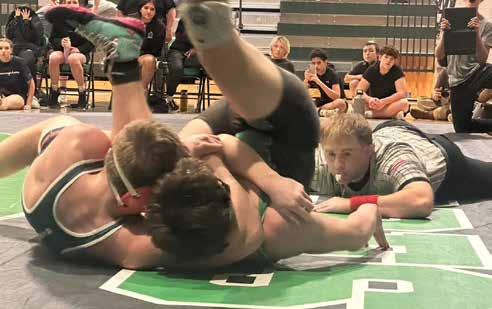
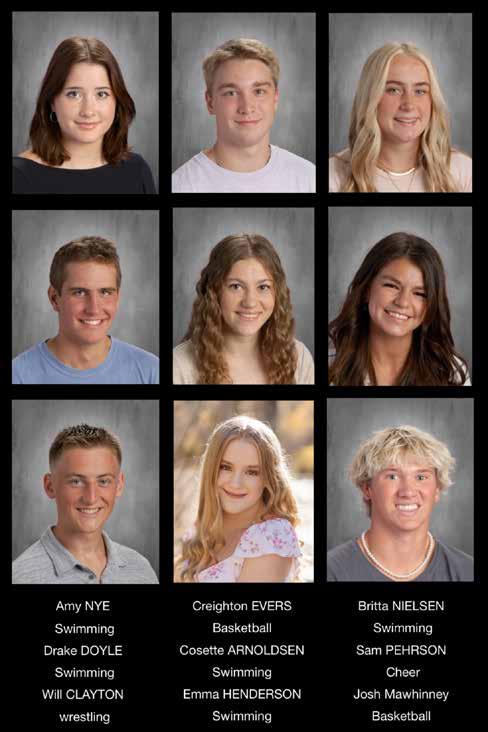


“We have had the honor to handle end-of-life care for a lot of very important people,” said Lance Larkin of the seven-generation business.
By Cassie Goff c.goff@mycityjournals.com
Imagine being a few days into a European cruise with your significant other. You’ve been enjoying your time at sea, exploring the sites and excursions, and reveling in some tasty food. Even though you’re thousands of miles away from your Utah-based company, clients, and community, your significant other teases you about not being recognized yet. Within 24-hours, you’re both in slight disbelief as you hear from over your shoulder “Hey, aren’t you…?”
This is a common occurrence for the Larkin family.
George William Larkin planted roots in 1863 in Ogden, where he began arranging funerals. In 1912, his son Alma J. Larkin opened Larkin Mortuary in Salt Lake City with the help of 25 employees.
Today, Larkin Mortuary is a seven-generation family company with over five locations (including The Rose Shop and Rocky Mountain Monument and Vault). Their primary locations being in Sandy on 1950 E. Dimple Dell Road, Riverton at 3688 W. 12600 South, and Downtown Salt Lake at 260 E. South Temple.
Larkin now employs over 200 individuals who will be helping them celebrate their 140th Anniversary this month.
Larkin is managed by President Lance C. Larkin, Jr. Executive Vice President Robert “Rob” A Larkin, Vice President Nicolhas N Larkin, Vice President Melissa Larkin Anderson, Secretary Lisa Larkin West, and Treasurer Heather Larkin Minson.
“When I was 22 and with my uncle, I was in awe of how many people were coming into the door. Now I see myself in those footsteps. My nephews ask me how I know so many people,” Lance said, smiling.
Lance began working 52 years ago (when he was 16 years old in 1973) washing cars, driving the florist vans, and mowing cemetery lawns. Serving as president for 25 years, he recalls the family and company history.
“When you start working, you start realizing how much help you can be to people who have lost a loved one,” Lance said.
He stated how working in this industry you see it all–from family members ecstatic that grandma isn’t in pain anymore, to the tragedy of a kid in a car crash.
“When I was younger, it really wore on me. It was emotionally challenging,” Lance said. Now, he takes nothing for granted.
“All of us have to get out of here one way or another,” Lance said. “It’s the circle of life and death, as much as it’s a part of it. It’s the end goal of all of us.”
Throughout the years, Lance has focused on vertical integration for the company. Part of that work has been bringing in more subsidiaries, contracts and services for Larkin to be a one-stop shop for end-of-life care.
Beginning with pre-planning services where advanced funeral planners ensure all details of preferred arrangements are taken care of in order to provide peace of mind for the family and ensure there’s no overspending.
“You can dictate what the service is going to be like,” Lance said.
Pre-planning services with Larkin ensure prices are frozen. Lance shared a story of a family member who pre-planned their services in 1989. Since the prices were frozen during pre-planning, that family was able to benefit from some pre-2000s economy pricing.. This was only one of more than 10,000 people who have pre-planned with Larkin over the decades.
“There is a sense of accomplishment in being successful helping people,” Lance said. “I see people at the grocery store and theatre all the time.”
Over the years, Lance has noted two substantial changes in industry trends.
“Women are taking over this business,” Lance said.
When he first started, there were only three women working in the entire company (in beautification and admin assisting). He remembers hiring Larkin’s first female licensed embalmer, who relocated from Canada. Now, all but two members of their embalming team are female.
In addition, Lance has noticed a general change in attitude when it comes to end-of-life arrangement preferences.
“Creamation has grown,” Larkin said. “When I first started, everyone was in the cemetery.”
Like any sustainable business, Larkin adapted to their clients needs. Now, even those cremated can be preserved in the cemetery.
Larkin provides options for remembering events for cremation with an urn, scatting gardens, resurrection gardens, epitaphs, auscenaries (communal scattering) and rock niches (where slots within boulders in the gardens are left open for ashes and can be accompanied with a name/date plate).
“Everyone wants to be a rock,” Larkin laughed.
Of course, Larkin still offers all of the more traditional end-of-life services like headstones, vaults and caskets. Companion crypts within the mausoleums are in current high demand.
Along with cremation services, the popularity of celebration-of-life events has risen. Larkin has worked to make these celebrations more of a “party” with options to schedule their greenhouse/event center, coordinate with their floral shops, and benefit from exclusive contracts with food caterers.

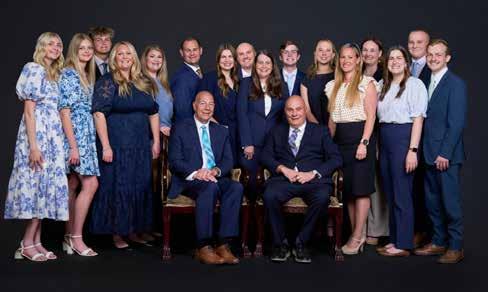
Larkin is dedicated to work with their clients and community members to fulfill any end-of-life request that may arise. They’ve previously worked with police motorcades and balloon releases. Even though Lance noted how he wouldn’t necessarily recommend balloon releases because of their effect on local wildlife.
“Things are outside. We have deer on site who will eat flowers. There are foxes and hawks that roam about,” Lance said.
Larkin, like many businesses, continue to offer services that became necessary during the pandemic.
“We zoom everything now and people appreciate it like crazy,” Larkin said, noting the frequent attendance of missionaries and out-of-state family members.
Lance recalled taking his grandkids to Disneyland and being recognized because of one of these services.
Even between all of the different offered services, Lance mentioned how important it is for people to recognize a final disposition.
“You still need to mourn and have closure," Lance said, mentioning that community members will also feel grief and want to share in recognition.
Some of the final services Larkin offers
are after-care oriented to help people walk through the process of filing for social security, distributing estates, making insurance claims and canceling licenses.
“It’s tough to close out a life,” he said.
Lance recalled a story of being able to take care of a granddaughter because she had found an itemized receipt from Larkin from the 1900s. His ancestors had taken care of her great grandfather - whose whopping total came to around $576.
Larkin also provides education and services for grief counseling, death education, funeral as ritual, writing a eulogy, helping children understand funerals and cultural differences in death, mourning and remembrance.
To celebrate their 140 year Anniversary, Larkin will be holding a series of open houses throughout the month. In addition, the Larkin elders will be continuing the tradition of riding in the Days of 47 Parade (and other local parades) in horse-drawn carriage with the Larkin youngers.
“We want to keep the legacy going,” Lance said. “We want our biggest accomplishment to be that we survived.”
“Even on a cruise ship over in Europe –they know Larkin.” l



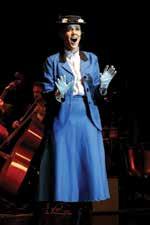



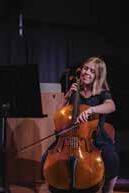








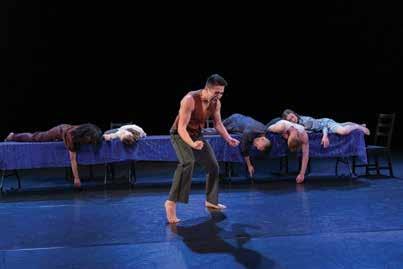














Mark Montague is synonymous with Brighton having attended Brighton in its first years as a school, serving as student teacher, teacher, coach, counselor and vice principal before taking his talents to Bingham, Riverton and Alta as vice principal and finally to Jordan High School as principal.
By Jerry S. Christensen j.christensen@mycityjournals.com
Cottonwood Heights in the 1960s was in transition from a rural bedroom community at the foot of the Wasatch Mountains to a vibrant suburb. Mark Montague was an integral part of that transformation.
“I remember Mark moving into the tightknit Stephensen Heights neighborhood in the 60s and immediately taking to the open fields and canyons,” said Dan Mackintosh who still lives in Cottonwood Heights’ Stephensen Heights. “Brighton High School was built just as Mark reached high school age and he embraced everything about Brighton.”
Montague was a class officer and a football player in the early 70s. He stayed on at


•
•



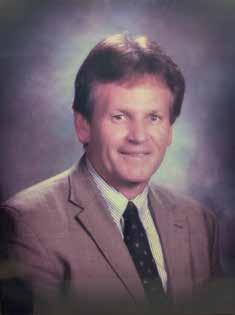
Mark Montague was a longtime Brighton teacher in Brighton’s “American Problems” civics classes and an esteemed coach during Brighton Wrestling’s record 11-year state championship streak. (Photo Camie Montague)
Brighton as a teacher aide after graduation while he studied at the University of Utah to become a teacher. He student taught at Brighton and then was offered a teaching position
for the going rate of $6,800 per year.
Montague’s ability to relate with students who were just a few years younger than him was recognized and he was soon paired with Huntsman Award-winning teacher Dave Chavis, a Vietnam veteran, who was just introducing a simulation-based teaching method that was Chavis’ master’s thesis. The Chavis/Montague teaching team introduced the “American Problems” civics curriculum which 50 years later is still a vibrant rite of passage for Brighton seniors. Aaron Hadfield currently continues the simulation-based course.
“Mark was an MUN giant in the Chavis tradition,” notes John McMorris, a 1978 BHS graduate who followed Montague’s example and returned to teach at his alma mater. In 1979, Mark took over Brighton MUN (Model United Nations) program and turned it into the state champion juggernaut that has maintained its dominance even today. He founded the Jordan School District’s middle school MUN conference which opened MUN to many more students, proved to be a strong educational program and became a feeder program for the Brighton program that went on to win national championships at the United Nations national competition in New York City.
Montague proved to be a polymath as he branched out into even more diverse fields.
Coach Montague became a state championship wrestling coach. He says that he was a skier rather than a wrestler in high school. However, Chavis and Don Neff had him join the wrestling team staff soon after he was hired as a teacher.
“Mark was one of the greats. He learned wrestling along with us but his leadership that he brought to us was where he shined,” recalled Scott Mackintosh, a state wrestler from the 1980’s teams. He was on the coaching staff that guided Brighton to a record 11-straight wrestling state championships. He remained close to the program and hosted a 50-year reunion of all Brighton wrestlers on his property in Riverton.
He died Jan. 20, 2025 at 71 after a final wrestle with Type 2 diabetes and severe vascular dementia. He was known by his friends, family and colleagues for his unending curiosity. He earned a bachelor’s degree from the University of Utah, Master of Educational Administration from BYU and a second master’s degree in counseling back at the University of Utah. His teaching and coaching blossomed into counseling at Brighton and into administration as a vice principal.
Brett Scharman, a UHSAA wrestling referee recalls, “Vice Principal Montague was still our wrestling coach even though he was in administration. He was and is a Brighton legend.”
















Jordan School District took note of the Brighton standout and soon he was vice principal at Bingham, Alta and the newly opening Riverton High School where he brought his enthusiasm and appreciation for traditions and school culture - learned from opening Brighton High as a student decades earlier. Jordan School District soon tapped Montague to be Principal Montague at the flagship Jordan High School. In retirement he founded Club Mud Pottery and traveled the West showing his hand creations at art fairs with his wife Camie Montague. And, he rarely missed a Battle of the Ax wrestling match between Brighton and arch rival Hillcrest. l



The South Valley Chamber held its annual State of the Chamber event and honored six community members for their contributions.
By Rebecca Olds rebecca.o@thecityjournals.com
TheSouth Valley Chamber hosted its annual State of the Chamber event at Salt Lake Community College’s Gail Miller Conference Center in Sandy.
CEO of the Chamber Jay Francis recapped the year of the Chamber. In 2024, the Chamber hosted 52 ribbon cuttings and more events, launched its first magazine, added 196 new members, grew their Women in Business program, expanded education offerings, increased advocacy efforts and expanded tourism efforts.
In particular, the Chamber’s impact on economic development and tourism in the area has been “off the charts,” Francis said— 10 events brought in more than 100,000 visitors/attendees which made a return of $24.7 million.
The chamber’s main goal is to “connect, educate, advocate, grow” local businesses in seven cities within the South Valley, including new city chamber members Herriman and Bluffdale.
At the event, six individuals within these recognized communities were honored for their work and positive impact on the community.
Heather Curtis of Swire Coca-Cola was awarded the Board Member of the Year. Rick Medina of the Mountain America Expo Center received the Tourism Award. Ashley
Guymon from Adaptive Arena received the community service award. Beth Colosimo from the Mill Entrepreneurship Center at Salt Lake Community College was awarded the Business Education Award. Lew Cramer of Colliers International, Utah received the President’s Award. Mieka Sawatzki, director of sales at the City Journals was awarded the Chamber Service Award.
For her volunteer efforts in the community and for the Chamber, Cory Covington, director of Business Development for the South Valley Chamber, presented the award to Sawatzki and called her a “champion of the chamber.”
“The Chamber Service Award is meant to honor someone who has gone above and beyond to serve and promote the South Valley Chamber, Mieka Sawatzki exemplifies this as a member of our ambassadors committee,” he said. “She is supportive in so many ways, from attending ribbon cuttings to working with our new members in our chamber, 101 meetings and just being a champion of the chamber in our community, her passion is contagious. I'm honored to call her my friend and to recognize Mieka Sawatzki as the 2024 Chamber Service Award recipient.”
Sawatzki has been in the world of advertising and marketing for nearly 10 years while being at the City Journals for the past six, where she currently holds the title of director of sales. She has been a chamber ambassador for two and currently sits on the Chamber’s Ambassador Committee which meets once a month.
“It's a pleasure for me to rub shoulders with these ladies and gentlemen,” Francis said of the ambassadors. “They have to leave
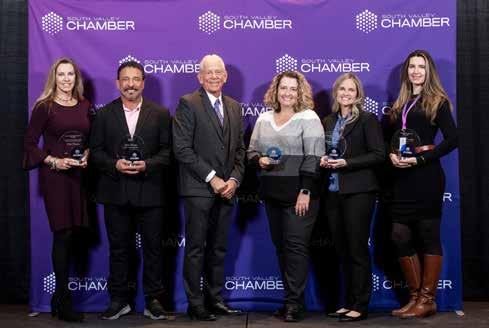
their businesses to come and help others open, but they get it—they were there and we appreciate them.”
As an ambassador, Sawatzki has attended and volunteered at chamber events such as lunches, award ceremonies, ribbon cuttings and more to help local businesses grow and thrive.
“With these businesses, a lot of them have no clue about marketing or advertising,” she said. “After doing sales and advertising for a long time, I have found that it is very rewarding to give them any and all of my knowledge on our products and other
ways they can help themselves, whether it's with the chamber or free marketing.”
She said that when Francis told her she would be receiving the Chamber’s Service Award, she felt both surprised and validated.
“A lot of the ambassadors go to a lot of the events and give time to so that was a surprise,” she said. “It felt awesome when he told me, because I do feel like I work really hard with the Journals in partnership with the Chamber.”
In 2024, Sawatzki estimated she volunteered around 156 hours in the chamber and attended 15 to 20 ribbon cuttings. l
Hundreds of students took part in popular musicals from “Beetlejuice” to “Willy Wonka” this spring.
By Julie Slama j.slama@mycityjournals.com
Fifty-eight Sprucewood second- through fifth-graders will step up to perform “Cinderella, If the Shoe Fits” this April.
The musical, directed by Christina Van Dam and featuring choreography by Madeleine Guymon, will be performed at 6:30 p.m., April 29 at Sprucewood Elementary, located at 12025 S. 100 East in Sandy.
This is just one of several student productions taking place this spring. Here are a few others:
• Sixth- through eighth-graders at Mt. Jordan Middle School will present “Beetlejuice, Jr.”, directed by Melissa Quinones. Performances will be held at 7 p.m. from April 17-20 at the school, located at 9351
Mountaineer Lane in Sandy.
• “The Wizard of Oz” will be presented by Altara Elementary students at 7 p.m., April 22-23 in the school’s multi-purpose room, 800 E. 11000 South in Sandy. It is directed by Lisa Pixton and Kirbie Dennison.
• “Willy Wonka Kids” will be staged at Glacier Hills Elementary in celebration of the 60th anniversary of Roald Dahl’s “Charlie and the Chocolate Factory.” The musical, directed by Camilla Duncan, will be performed at 6:30 p.m. from May 13-15 at the school, located at 1085 E. Galena Drive in White City.
Additionally, “Curtains,” a murder-mystery whodunnit, was performed in March by 105 students at Draper Park Middle School, under the direction of Erica Heiner and with music direction by Carl Tensmeyer. Oakdale Elementary also staged “Willy Wonka” in late March. l













































































Peri Kinder Life and Laughter
Russia is our ally. Canadians are the enemy. Tariffs will make us richer but we’re cutting staff at national parks. Measles is back. Gaza is the new Riviera. The economy is crashing and it’s tax season when I pay thousands of dollars to the government so it can purchase Tesla Cybertrucks to send to Jupiter.
The newspeak and doublethink we endure each day can be a bit overwhelming, but I’ve found a way to get through the endless cycle of breaking news: denial.
Denial is a beautiful, hazy way to spend your day. Instead of crying through a CNBC report, denial allows you to drift on a cloud of puff pastry surrounded by cherry trifle and savory scones.
This specific form of denial is “The Great British Bake Off” and it saved me during March when I was knee-deep in tissues, cough syrup and tariff wars. There’s only so much idiocy one can endure while healing from pneumonia.
Unlike American reality shows that foster cruelty and conflict, GBBO features a dozen creative bakers who just want to make

the best Victoria sponge cake or sticky toffee pudding. The contestants are kind, positive and willing to offer a helping hand.
I love British television because everyone looks real. There are no plastic surgery junkies or steroid-addicted chefs, just regular people doing something they love. When the judges, Paul Hollywood and Dame Prue Leith, make a criticism, it’s done with a British accent so it doesn’t sound so awful.
When Prue tuts and says, “This bake is a disaster,” she could easily be tucking a blanket around your shoulders and handing you a steaming cup of Earl Grey.
Instead of watching Elon Musk wield a chainsaw, I tune into GBBO which is filmed on the grounds of an English manor. Bunnies and squirrels scamper through grassy meadows like a Disney movie. There’s even a fanbase dedicated to identifying the different bird songs heard during the show.
The pastel-colored set, with its matching counters, ovens and fridges, distracts me from personnel cuts at federal agencies including

the CDC and FAA. GBBO hosts Alison Hammond and Noel Fielding wander through the competition, amusing bakers with their British humor and offering pep talks to stressed cooks.
Each episode has a specific theme. There’s bread week or pastry week or biscuit week, and each chef creates a signature bake, completes a technical challenge and makes a jaw-dropping showstopper. It’s a heartwarming alternative to the 24/7 chaos of the Trump administration.
Who knew there were so many British bakery items? But I have to admit, there are things they make I would never eat, including black pudding and chorizo buns topped with mustard custard. Nope.
Instead of worrying about the breakdown of our country’s system of checks and balances, I worry about whether my favorite



baker can create a pie crust that doesn’t have a soggy bottom. The judges hate soggy bottoms. I’ve also learned to worry about fallen focaccia, overcooked tarts and croissant dough that’s not properly laminated. Even the mistakes feel cozy.
I’m impressed at how quickly chefs can whip up a batch of pistachio macarons, ginger tarts or spanakopita (a spinach and feta pie my husband would NEVER eat) with minimal tears or tantrums. It’s a reminder things can get done without fits of temper, vengeance or manipulation.
Denial is not a permanent solution but it’s a tool when messages from Big Brother and the Ministry of Truth get to be a bit much. Just turn on the TV and float away in a delicate orange buttercream or raspberry whipped cream. It’s some sweet positivity in a decidedly bitter time.




